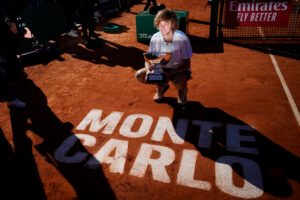The 17-Year-Old Russian Sensation – Mirra Andreeva
Mirra Andreeva didn’t arrive quietly. She stormed into the spotlight with back-to-back WTA 1000 titles at just 17, flattening top seeds and rewriting the record books in real time.
Her recent victories in Indian Wells and Dubai didn’t bring trophies alone. They propelled her into the WTA’s top six—quicker than any teenager in more than a decade. She’s not biding time for the future. She’s creating it now.
No other player her age is matching that pace. And nobody else is beating world No. 1s with the calm, control, and calculation she’s already mastered.
Career Highlights:
- Singles Titles: Andreeva has secured three WTA singles titles:
- Iași Open (WTA 250): July 2024, defeated Elina Avanesyan.
- Dubai Championships (WTA 1000): February 2025, overcame Clara Tauson.
- Indian Wells Open (WTA 1000): March 2025, bested Aryna Sabalenka.
- Grand Slam Performance:
- Australian Open: Reached the fourth round in 2024 and 2025.
- French Open: Semifinalist in 2024.
- Wimbledon: Advanced to the fourth round in 2023.
- US Open: Second-round appearances in 2023 and 2024.
- Olympics: Won a silver medal in women’s doubles at the 2024 Paris Olympics, partnering with Diana Shnaider.
Career Statistics:
- Singles Record: 128 wins – 37 losses.
- Doubles Record: 27 wins – 19 losses.
- Career Prize Money: $4,936,920.
Notable Achievements:
- Became the youngest player to win a WTA 1000 title at the Dubai Championships in February 2025.
- Entered the WTA Top 10 rankings at the age of 17, the youngest since Nicole Vaidisova in 2007.
- Named WTA Newcomer of the Year in 2023.
Early Life and Tennis Beginnings
Mirra learned a racquet at the age of five. She grew up in Krasnoyarsk, Siberia—a far cry from Spain or Florida tennis camps. That didn’t deter her. Her mother, a retired coach, taught her how to play and coached her through her early years. She practiced indoors on cold Russian winters, developing the toughness and discipline that is now part of her on-court persona.
When she broke onto the ITF junior circuit, however, it was clear that she was not just blessed—she was built differently. She was a runner-up in the junior French Open in 2022. A year later, she applied that pace to the WTA tour and set about racking up wins over established players.
That leap wasn’t gradual. It was sharp, fast, and loaded with intent.
Breakthrough Performance at the Dubai Tennis Championships
Dubai wasn’t just a win – it was a signal.
At 17, Andreeva made her way through one of the toughest WTA 1000 draws of the year. She defeated three Grand Slam title winners in a week – Marketa Vondrousova, Elena Rybakina, and Iga Świątek. Every match offered a new enigma. She cracked all of them.
Her movement looked effortless. Her shot choices? Ice-cold. She played like someone who’d already been in five finals, not someone chasing her first.
The win made her the youngest WTA 1000 champion since the format began in 2009. It also cemented her place as a threat—not someday, but now.
Playing Style and Strengths
Mirra doesn’t rely on one club – she controls the tempo with all of them. Her backhand, her two-hander, is snug, explosive, and on-target under pressure. Most opponents try to exploit an adolescent backhand. With Mirra, they don’t.
What sets her apart is not just sharp shot-making. It’s the variety. She is able to redirect power, neutralize angles, and slip in drop shots with subtlety. The movement from aggressiveness to touch is seamless.
Mentally, she plays like a woman a decade older than her. She doesn’t go for points. She builds them – one upon another – waiting for the gap, not making it. And when the gap comes, she hits effectively.
Coaching Influence of Conchita Martínez
Mirra’s game didn’t evolve in a vacuum. Since teaming up with Conchita Martínez, she’s made strategic leaps that go far beyond her baseline comfort zone.
Conchita’s dominance is displayed in her strategic command. Games are choreographed like chess – not simply hit-and-hope ball pounding. Opponents are dismantled systematically, with certain goals and habits that refuse to waver under duress.
They’ve executed a trust-building process at the rapid pace of any franchise player. Andreeva leverages Martínez’s experience – know-how not as the retired Grand Slam champion, but as a coach who knows how to mold untried youth into title-worthies. That chemistry is already starting to pay off.

Recent Success at Indian Wells
Just weeks after her breakthrough in Dubai, Mirra went back-to-back in Indian Wells—taking down the world No. 1 in the final.
Aryna Sabalenka brought the heat. Mirra brought accuracy. She absorbed pace, steered it with angle, and denied Sabalenka from getting in sync. In straight sets, she concluded her second WTA 1000 title—on one of tennis’s grandest stages.
What produced headlines beyond the win? Her notebook. She filled it out between sets, notes and adjustments from match to match. Commentators and fans noticed. So did competitors. She’s not just reacting. She’s breaking it down—live, in-game, accurately.
Climbing the WTA Rankings
Back-to-back WTA 1000 titles aren’t merely news-making – they realign rankings. Dubai put Mirra Andreeva in the conversation. Indian Wells made it a reality. She’s still just 17, but now world No. 6.
No teenager had reached the top 10 so quickly since 2007. No accident. Her wins included defeating a number of Grand Slam winners, and she did not just hang on in those matches – she dominated them.
Every event unearthed another dimension of her tennis. And the WTA didn’t give credit to hype. They gave credit to the results. She stood out above vets who have been grinding for years. That only happens when performance is matched with composure.
Future Prospects and Expectations
The No. 5 looks in sight. So is No. 1. That’s the buzz going around the locker rooms and post-match sessions. Pundits aren’t questioning whether she’ll capture a Slam – they’re debating which one arrives first.
Her game is physically Grand Slam-ready. The serve doesn’t break down under pressure, the movement never breaks down during extended rallies, and the backhand doesn’t miss more than the odd moment. But it’s the mind that controls the body that makes her different.
She reads like an old pro. She adjusts in mid-point. She takes down notes on changeovers – not for theatrics, but for planning. Players that are disciplined last longer and go farther.
If she keeps her team tight and stays healthy, she’s not just a rising name – she’s the future of women’s tennis.
Conclusion
Mirra Andreeva didn’t arrive quietly. She stormed into the WTA spotlight, took out top seeds, and walked away with hardware—twice.
From junior promise to elite performance, she’s moved faster than most thought possible. And she’s done it all at 17, with a calm, tactical presence that’s rare at any age.
The tennis world’s watching closely. Not because she’s young, but because she’s different. She’s already left her mark. Now the question is—how far can she take it?









Comments: 0